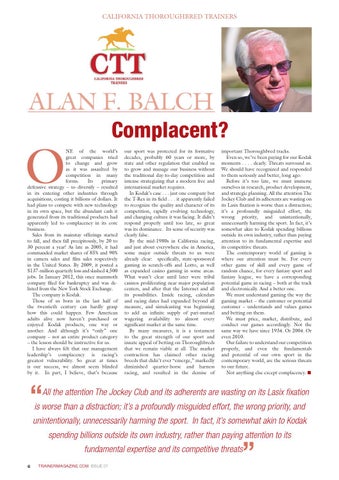CALIFORNIA THOROUGHBRED TRAINERS
ALAN F. BALCH Complacent?
O
NE of the world’s great companies tried to change and grow as it was assaulted by competition in many forms. Its primary defensive strategy – to diversify – resulted in its entering other industries through acquisitions, costing it billions of dollars. It had plans to compete with new technology in its own space, but the abundant cash it generated from its traditional products had apparently led to complacency in its core business. Sales from its mainstay offerings started to fall, and then fall precipitously, by 20 to 30 percent a year! As late as 2005, it had commanded market shares of 85% and 90% in camera sales and film sales respectively in the United States. By 2009, it posted a $137-million quarterly loss and slashed 4,500 jobs. In January 2012, this once mammoth company filed for bankruptcy and was delisted from the New York Stock Exchange. The company is Kodak. Those of us born in the last half of the twentieth century can hardly grasp how this could happen. Few American adults alive now haven’t purchased or enjoyed Kodak products, one way or another. And although it’s “only” one company – not an entire product category – the lesson should be instructive for us. I have always felt that our management leadership’s complacency is racing’s greatest vulnerability. So great at times is our success, we almost seem blinded by it. In part, I believe, that’s because
our sport was protected for its formative decades, probably 60 years or more, by state and other regulation that enabled us to grow and manage our business without the traditional day-to-day competition and intense strategizing that a modern free and international market requires. In Kodak’s case . . . just one company but the T-Rex in its field . . . it apparently failed to recognize the quality and character of its competition, rapidly evolving technology, and changing culture it was facing. It didn’t respond properly until too late, so great was its dominance. Its sense of security was clearly false. By the mid-1980s in California racing, and just about everywhere else in America, some major outside threats to us were already clear: specifically, state-sponsored gaming in scratch-offs and Lotto, as well as expanded casino gaming in some areas. What wasn’t clear until later were tribal casinos proliferating near major population centers, and after that the Internet and all its possibilities. Inside racing, calendars and racing dates had expanded beyond all measure, and simulcasting was beginning to add an infinite supply of pari-mutuel wagering availability to almost every significant market at the same time. By many measures, it is a testament to the great strength of our sport and innate appeal of betting on Thoroughbreds that we remain viable at all. The market contraction has claimed other racing breeds that didn’t ever “emerge,” markedly diminished quarter-horse and harness racing, and resulted in the demise of
important Thoroughbred tracks. Even so, we’ve been paying for our Kodak moments . . . . dearly. Threats surround us. We should have recognized and responded to them seriously and better, long ago. Before it’s too late, we must immerse ourselves in research, product development, and strategic planning. All the attention The Jockey Club and its adherents are wasting on its Lasix fixation is worse than a distraction; it’s a profoundly misguided effort, the wrong priority, and unintentionally, unnecessarily harming the sport. In fact, it’s somewhat akin to Kodak spending billions outside its own industry, rather than paying attention to its fundamental expertise and its competitive threats. The contemporary world of gaming is where our attention must be. For every other game of skill and every game of random chance, for every fantasy sport and fantasy league, we have a corresponding potential game in racing – both at the track and electronically. And a better one. We must understand gaming the way the gaming market – the customer or potential customer – understands and values games and betting on them. We must price, market, distribute, and conduct our games accordingly. Not the same way we have since 1934. Or 2004. Or even 2010. Our failure to understand our competition properly, and even the fundamentals and potential of our own sport in the contemporary world, are the serious threats to our future. Not anything else except complacency. ■
“
All the attention The Jockey Club and its adherents are wasting on its Lasix fixation
is worse than a distraction; it’s a profoundly misguided effort, the wrong priority, and
unintentionally, unnecessarily harming the sport. In fact, it’s somewhat akin to Kodak spending billions outside its own industry, rather than paying attention to its
”
fundamental expertise and its competitive threats 6
TRAINERMAGAZINE.COM ISSUE 37
